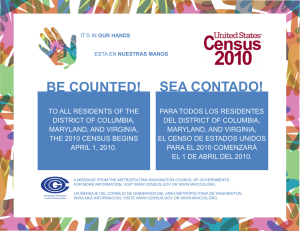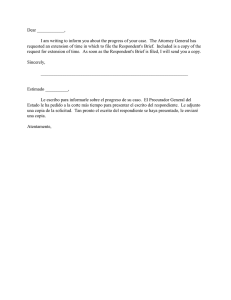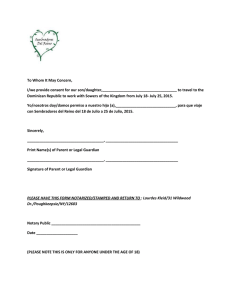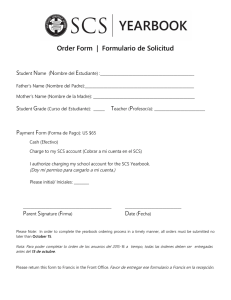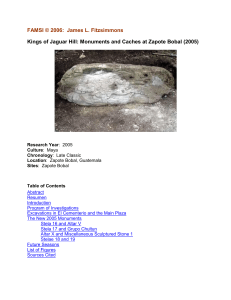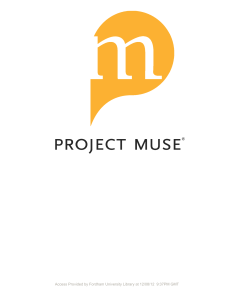The Monuments in the Izapan Ballcourt
Anuncio
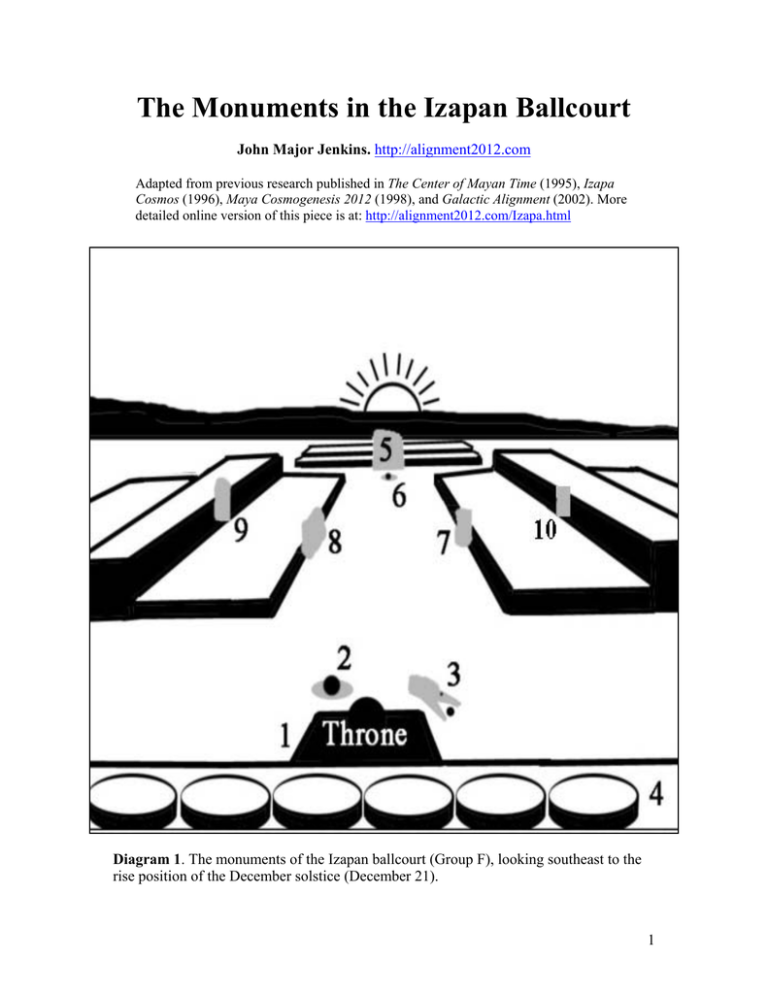
The Monuments in the Izapan Ballcourt John Major Jenkins. http://alignment2012.com Adapted from previous research published in The Center of Mayan Time (1995), Izapa Cosmos (1996), Maya Cosmogenesis 2012 (1998), and Galactic Alignment (2002). More detailed online version of this piece is at: http://alignment2012.com/Izapa.html Diagram 1. The monuments of the Izapan ballcourt (Group F), looking southeast to the rise position of the December solstice (December 21). 1 Description of the numbered monuments in Diagram 1: 1. The Throne. Solar god head emerging from between legs on east face. Thrones denote the cosmic center. 2. Ball and ring. The ballgame. 3. A serpent head, upside down. Probably had a solar ball or sun-face in its open mouth. These were sometimes used in ballcourts or on buildings as corner markers. All three of these symbol complexes relate to the rebirth of the December solstice sun. 4. Six stone viewing seats, facing out over the ballcourt to the southeast sunrise horizon. 5. Stela 60. Depicts one of the Hero Twins standing over a fallen Bird Deity. Seven Macaw, the Big Dipper (Ursa Major) is defeated. 6. Ball and ring, in front of Stela 60. The ball game. 7. Sky Lifter carving. Very eroded, but similar to the “Sky Lifter” carving found in the nearby village of Tuxtla Chico. Similar to the Olmec Sky Lifter deity (see pictures). 8. Stela 67. Similar to Stelae 11 and 22. Here, One Hunaspu sits in the middle of a cosmic canoe (the Milky Way). His outstetched arms indicate a “period ending” event. 9. Stela 69. A carving fragmented in three parts. Enough is left to notice the Seven Macaw Bird Deity, fleeing from two figures on the left, probably the Hero Twins. 10. Inverted T-shape stone, in the middle of the south wall. One-half of an Otherworld portal. Similar to Stela 14 (see pictures). *********** The ball court at Izapa is 2,000 years old. Some of the monuments are even older than this, perhaps to 300 BCE. The monuments in the ball court tell the story of the Maya Creation Myth, the Popol Vuh. The Hero Twins must destroy the tyrant, Seven Macaw. Then they can play the ballgame, defeat the other Lords of Death, and help their father be reborn. He can then take his throne. The ball court is aligned with the solstice sunrise, December 21. The Big Dipper rises and falls over Tacana volcano, to the north. Because of these astronomical alignments, we can see how the Creation Myth tells the story of events in the sky. The Big Dipper (Seven Macaw) falls in the northern sky. In the southeast, the sun on the solstice (One Hunahpu) is reborn. It is a story of World Ages, so the rebirth of One Hunahpu is about rebirth of the sun, the world, on the solstice in 2012 AD. The old deity must be sacrificed before it can happen. At period endings, prayers and offerings and sacrifices are made to help the renewal of humanity and the world. 2 Numbers 1, 2, and 3 in Diagram 1: Viewing seats behind the Throne (#4 in Diagram 1): 3 Stela 60 (#5 in Diagram 1): [Not pictured: Number 6 in Diagram 1 is another stone ball in a stone ring.] Below: Sky Lifter deity (#7 in Diagram 1) --- San Martin Sky Lifter (left); Tuxtla Chico “Danzante” Sky Lifter (middle); eroded Izapa Sky Lifter from ballcourt (right). 4 Stela 67 (#8 in Diagram 1) Stela 69 (#9 in the diagram) drawing from Garth Norman’s BYU study of Izapa: 5 No. 10 in Diagram 1, Miscellaneous Monument 61: This inverted T-shape symbol is found elsewhere at Izapa, including Stela 14, in which it represents the “jaguar womb” containing the Hero Twins: photo from Garth Norman’s BYU study of Izapa 6 More detailed description of the monuments in the Group F ball court 1. Throne. Has solar god head emerging from between legs on east face. Four short pedestal legs. No carving on top, but might be eroded. Throne 1 in Group B has an elaborate cross design on top. Thrones denote the cosmic center. 2. Ball and ring. Referential to ballgame. Analogous to nearby “sun between legs” of throne (the “seed in cleft” image which is the hieroglyph for the ballgame). 3. Serpent head, upside down, probably had solar ball or sun-face in its open mouth. These were sometimes used in ballcourts or on buildings as corner markers. The sun-inmouth image is analogous to the throne’s sun-head and the ball-in-ring carvings. All three of these symbol complexes relate to the same archetypal image of the sun in “a cleft.” This could be a mouth, a goal-ring, or a birth canal. The throne points down the lengthwise axis of the ballcourt toward the sunrise position of the December solstice sun. 4. Six stone viewing seats. That the solstice sunrise sightline was significant is strongly suggested by these council seats, which afforded an elevated view of not only the ballfield, but the December solstice sunrise. Anyone sitting on these seats would look over the following two carvings (5 and 6) on the far eastern end of the ball court. 5. Stela 60. Depicts one of the Hero Twins standing over a fallen Bird Deity. The carvings and orientation of Group A indicate that this Bird Deity represents the Big Dipper to the north, rising and falling over Tacana volcano. In the Maya Creation Myth, the Big Dipper is Seven Macaw, the vain and false ruler of the previous World Age. The Hero Twins facilitated his downfall so that their father, One Hunahpu (a SOLAR lord), could be resurrected. Given the viewing orientation of the viewing seats and anyone standing in front of Stela 60, we are justified in suspecting that the solar rebirth will be found happening over the solstice horizon. And the December solstice itself is the rebirth of the sun in the annual cycle. But the Creation Myth, which is the subject of these carvings, is concerned with the shifting of World Ages, implying we must be sensitive to recognizing a much larger cycle of solar rebirth (a new “Sun” or “Age”). 6. Ball and ring, in front of Stela 60. This, like the one on the opposite end of the ball court, refers to the ballgame and the set of “sun-in-cleft” references. In the predawn sky over the solstice horizon, a cleft feature on the Milky Way would have been observed 2,100 years ago, during Izapa’s heyday. This is the “Black Road” or “Great Cleft” formed by interstellar dust in the region of the Milky Way’s “nuclear bulge” or Galactic Center. This was known to the Maya as the Xibalba be (the Road to the Underworld), which could also be portrayed as the mouth of a jaguar or sky dragon (as on Izapa Stela 25). In ballgame symbolism, the ballcourt was associated with the Milky Way and the goal-ring was associated with the Great Cleft. Some 2,100 years ago, the solstice sun and the Great Cleft were separated by about 30 degrees. Today, they have converged via the precession of the equinoxes. In other words, the solstice sun and the Great Cleft are 7 joined in the years around 2012 AD. The profound implications of this are the primary focus of my research. 7. Sky Lifter carving. Very eroded, but identifiable via similar characteristics with a Sky Lifter carving found in the nearby village of Tuxtla Chico. An Olmec Sky Lifter, recovered from the cone of San Martin Volcano near the Gulf Coast, was interpreted as a being who lifts the Milky Way into place as the Axis Mundi—a dawn-time Creation event. He holds a bar that he turns upward, from horizontal to vertical. This suggests a movement of the Milky Way. This carving was found in the middle of the south wall of the ballcourt. Directly opposite, in the middle of the north wall, Stela 67 was found. 8. Stela 67. Similar to Stelae 11 and 22. Here, a solar lord sits in the middle of a cosmic canoe. Incised bones from Tikal reveal that celestial canoes represented the Milky Way. His outstetched arms indicate a “period ending” event. He is probably the Hero Twins’ father, One Hunahpu, who is resurrected at the end of the Age, after they defeat Seven Macaw and the Lords of the Underworld. The sun located in the middle of the Milky Way canoe is compelling. Combined with the emphasis on the solstice sun via the ballcourt’s orientation, and other arguments omitted here, this solar deity (One Hunahpu) is probably the December solstice sun lord. The seating declivity of canoes could easily be seen to be analogous to the Great Cleft of the Milky Way, which shares this astronomical identification with so many other mythological adumbrations. In such a scenario it becomes difficult to avoid deducing that the entire complex of carvings in the Izapan ballcourt express the alignment of the solstice sun lord with the Great Cleft in the Milky Way. Such a rare alignment occurs via precession, and it happens in the era of the 13-baktun cycle’s ending date, December 21, 2012. 9. Stela 69. A carving fragmented in three parts. Enough is left to notice the Seven Macaw Bird Deity, in a state of fleeing or flight from two figures on the left, probably the Hero Twins. As with Stela 25, this carving depicts some episode from the Hero Twin myth, perhaps the arm of Hunahpu being torn off or Seven Macaw being shot at. At any rate, Seven Macaw has not yet fallen, as on Stela 60. A person viewing Stela 69, which is above Stela 67 on the upper tier of the ballcourt, would look to the north, where the Big Dipper rose and fell over Tacana volcano during Izapa’s heyday. In confirmation that this northern sighting direction was part of the ballcourt cosmogony, the pillar monument a dozen yards northwest of the ballcourt faces Tacana volcano. 10. Inverted T-shape stone, in the middle of the south wall. this inconspicuous stone is actually very revealing of how "the middle" of the ballcourt was conceived. The stone is very much like the "container" on Stela 14, (Group C) in which the Hero Twins are enwombed and over which a jaguar-serpent arches. It is also one-half of a quadrated cartouche which symbolizes the portal to the Otherworld (see discussion in part 2 below). This inverted T-shape represents a vessel, a container, and a womb. A viewer could watch the nuclear bulge of the Milky Way pass through the southern meridian on certain nights. In fact, at certain times on certain nights, the Milky Way stretches in a SE-NW orientation which mirrors the orientation of the ballcourt itself. 8 The Monuments in the Izapan Ballcourt John Major Jenkins. http://alignment2012.com Adapted from previous research published in The Center of Mayan Time (1995), Izapa Cosmos (1996), Maya Cosmogenesis 2012 (1998), and Galactic Alignment (2002). More detailed online version of this piece is at: http://alignment2012.com/Izapa.html Diagrama 1. Los monumentos en la cancha de pelota de Izapa (Groupo F). Alineacion con el sol de solsticio (21 de diciembre) en el sudeste. 9 Descripción de los monumentos numerados en Diagrama 1: 1. El Trono. Cabeza de dios solar emergiendo entre las piernas de la cara este. Tronos indican el centro cósmico. 2. Pelota y anillo. El juego de pelota. 3. Una cabeza de serpiente, al revés. Probablemente tenía un disco solar o cara de sol en su boca abierta. Estos a veces eran utilizados en canchas de pelota o en edificios como marcadores de esquina. Los tres complejos de símbolos están relacionados al renacimiento del sol de solsticio de diciembre. 4. Seis asientos de contemplación de piedra. 5. Stela 60. Muestra uno de los Héroes Gemelos parado sobre una deidad de pájaro caído. Siete Guacamayo, la Osa Mayor, es derrotado. 6. Pelota y anillo, frenta a Stela 60. El juego de pelota. 7. "Elevador del Cielo" tallado. Muy erosionado, pero similar al tallado "Elevador del Cielo" encontrado en el pueblo cercano de Tuxtla Chico. Similar a la deidad olmeca del Elevador del Cielo (ver imágenes). 8. Stela 67. Similar a Stela 11 y 22. Aquí, Hun Hunahpu está sentado en el medio de una canoa cósmica (la Vía Láctea). Sus brazos estrechos indican un evento que termina un período. 9. Stela 69. Un tallado fragmentado en tres partes. Quedó lo suficiente para notar a la deidad de Siete Guacamayo, huyendo de dos figuras a la izquierda, probablemente los Héroes Gemelos. 10. Piedra en forma de "T" invertida, en el medio de la pared sur. Una mitad de un portal del Otro Mundo. Similar a Stela 14 (ver imágenes). La cancha de pelota de Izapa tiene 2,000 años de antiguedad. Algunos de los monumentos son aún más antiguos que éste, probablemente 300 AC. Los monumentos de la cancha de pelota cuentan la historia del mito creacional de los Mayas, el Popol Vuh. Los Héroes Gemelos deben destruir al tirano, Siete Guacamayo. Entonces pueden jugar el juego de pelota, derrotar a los otros Señores de la Muerte, y ayudar a su padre de renacer. Entonces él puede ocupar su trono. La cancha de pelota está alineada con la salida del sol de solsticio, 21 de diciembre. La Osa Mayor asciende y desciende sobre el volcán Tacana, al norte. Debido a estas alineaciones astronómicas podemos ver cómo el mito creacional cuenta la historia de eventos en el cielo. La Osa Mayor (Siete Guacamayo, Vucub Caquix) está en el cielo del norte. En el sudeste, el sol de solsticio (Hun Hunahpu) renace. Es una historia de las Épocas de la Tierra, entonces el renacimiento de Hun Hunahpu es acerca del renacimiento del sol, del mundo, en el solsticio de 2012 AD. La deidad antigua debe ser sacrificada antes de que pueda suceder. En los finales de períodos, oraciones, ofrendas y sacrificios se hacen para ayudar a la renovación de la humanidad y del mundo. 10


